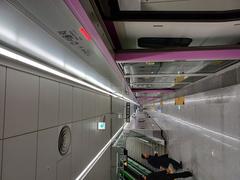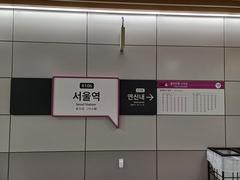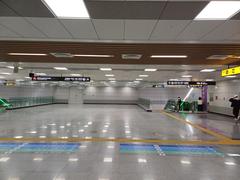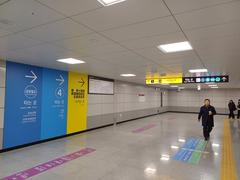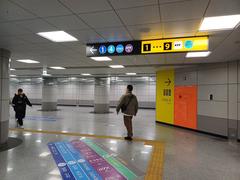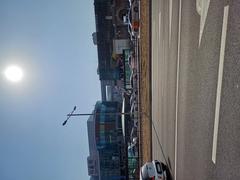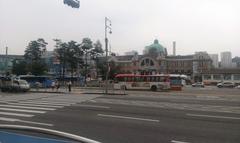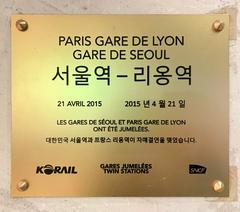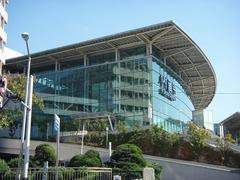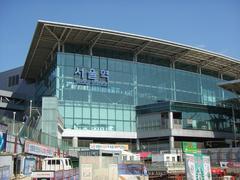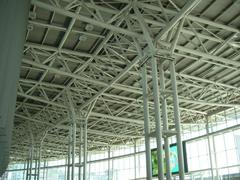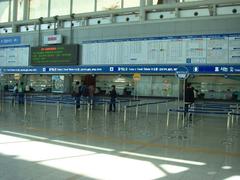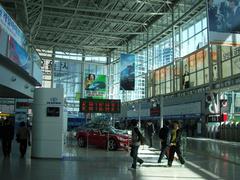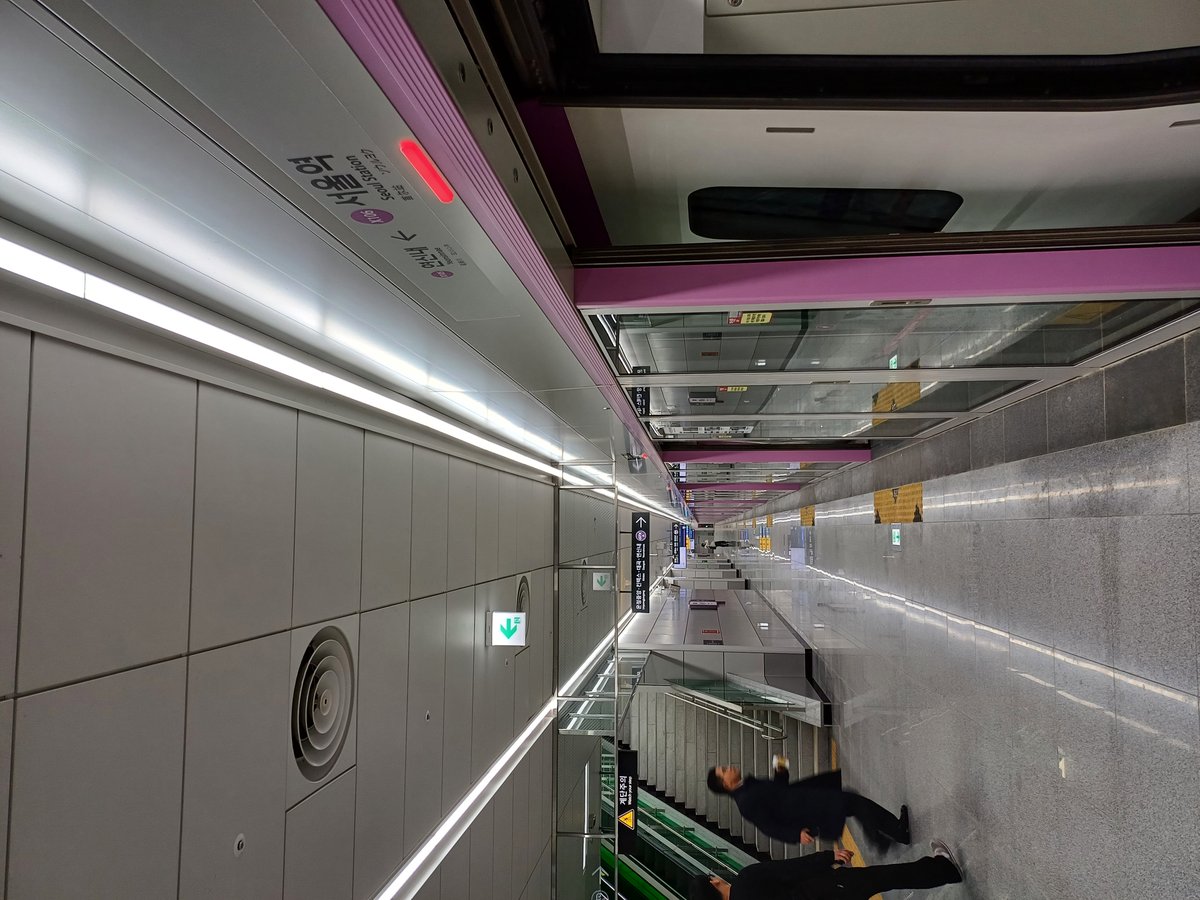
Seoul Station: Complete Guide to Visiting Hours, Tickets, History, and Nearby Attractions
Date: 14/06/2025
Introduction: Seoul Station’s Historical and Cultural Significance
Seoul Station, at the heart of South Korea’s capital, is far more than a major transportation hub—it is a powerful symbol of the nation’s journey through colonization, modernization, and cultural renaissance. Originally opened in 1925 as Gyeongseong Station during the Japanese colonial era, the station’s iconic red-brick façade and Byzantine-style central dome stand as enduring reminders of Seoul’s evolving urban narrative (The Smart Local). Today, Seoul Station seamlessly connects high-speed KTX trains, subway lines, and the AREX airport express, while the preserved original building—now Culture Station Seoul 284—serves as a vibrant venue for arts and heritage events (Korean Culture Center).
This guide provides essential information for visitors, including practical details on visiting hours, ticketing, accessibility, transportation connections, nearby attractions, and expert travel tips. Whether you’re transiting through Seoul or delving into its layered history, Seoul Station offers an unmatched blend of convenience and culture (Open Korea).
Table of Contents
- Historical Overview and Early Development
- Key Historical Roles and Modernization
- Architectural and Cultural Highlights
- Transportation and Urban Connectivity
- Visiting Seoul Station: Hours, Tickets, and Accessibility
- Top Nearby Attractions and Experiences
- Facilities, Travel Tips, and Traveler Services
- Frequently Asked Questions (FAQ)
- Legacy and Continuing Impact
- References and Further Reading
Historical Overview and Early Development
Seoul Station began as Gyeongseong Station in 1925, designed by Tsukamoto Yasushi of Tokyo Imperial University. Its Western-influenced architecture, especially the red brickwork and Byzantine dome, was intended to symbolize Korea’s entrance into modernity (The Smart Local). Strategically located near the Han River, the station anchored key rail lines—like the Gyeongbu Line to Busan and the Gyeongui Line to the northwest—catalyzing Seoul’s urban and economic growth (Train Spread).
Key Historical Roles and Modernization
Colonial and Post-Liberation Periods
During the Japanese occupation, the station was pivotal for civilian and military logistics. Post-1945, it symbolized national recovery, facilitating movement and reconstruction after the Korean War (Open Korea). As Seoul industrialized in the 1960s and 70s, Seoul Station’s importance only grew.
Modernization and Expansion
Designated as Historic Site No. 284 in 1981 (The Smart Local), the original station was ultimately replaced for daily operations by a new, larger terminal in 2004. This facility supports the KTX high-speed rail, AREX airport trains, and multi-line subway connections (Train Spread). The historic building, meanwhile, was restored and reopened as Culture Station Seoul 284, highlighting the city’s dedication to both heritage and innovation.
Architectural and Cultural Highlights
Culture Station Seoul 284
The original station building, now Culture Station Seoul 284, is a masterwork of early 20th-century architecture—its central dome, arched windows, and granite-finished halls evoke a unique blend of Western and Korean aesthetics (Wikipedia). After closing as a transit hub in 1988, the building was meticulously restored and, since 2011, has hosted exhibitions, performances, and community programs (Korean Culture Center).
Modern Station and Urban Integration
The 2004 terminal, with its glass façades and open concourses, exemplifies Seoul’s commitment to modern public infrastructure. The juxtaposition of historic and contemporary design tells the story of a city bridging past and future.
Seoullo 7017 Skygarden
Directly adjacent to Seoul Station, Seoullo 7017 is an elevated urban park built atop a former highway overpass. Spanning over 1 km, it features themed gardens, art installations, cafés, and panoramic views—especially striking at night (The Soul of Seoul).
Transportation and Urban Connectivity
Seoul Station is the country’s primary rail gateway, serving:
- KTX High-Speed Rail: Rapid links to Busan, Daejeon, Daegu, and more
- AREX (Airport Railroad Express): Direct access to Incheon and Gimpo Airports
- Seoul Metro Lines 1 & 4: Easy access to key city districts
- Intercity, Regional Trains, and Buses: Connections across South Korea
- Taxi and Rideshare: Plentiful options at station entrances
Its extensive facilities—ticketing, luggage storage, multilingual information, and traveler services—make it the preferred entry point for domestic and international visitors (Train Spread; KoreaToDo).
Visiting Seoul Station: Hours, Tickets, and Accessibility
Visiting Hours
- Main Station and Platforms: 24 hours for train access
- Culture Station Seoul 284: 10:00 AM–7:00 PM, Tuesday–Sunday (closed Mondays/public holidays)
- Ticket Counters: Typically 5:30 AM–10:30 PM; check official sources for specifics
Ticket Information
- KTX/AREX/Intercity Trains: Purchase at station kiosks, staffed counters, or online (KORAIL)
- Culture Station Seoul 284: Admission is generally free; some exhibitions require tickets (Korean Culture Center)
- T-money Card: Usable for subway, buses, and some taxis—available for purchase and recharge at station kiosks
Accessibility
- Elevators, ramps, tactile paving, and accessible restrooms throughout
- Multilingual staff and information desks
- Baby care rooms and barrier-free facilities for travelers with disabilities
Practical Travel Tips
- Arrive early during holidays or peak travel times
- Use digital station maps and navigation apps (Kakao Maps, Naver Maps)
- Lockers and staffed luggage storage are available (₩2,000–₩6,000 per day)
- Free Wi-Fi and currency exchange on site
- Download the Audiala app for real-time updates and guides
Top Nearby Attractions and Experiences
- Seoullo 7017 Skygarden: Directly connected; best for evening walks and city views
- Namdaemun Market: 10-minute walk; Korea’s largest traditional market (KoreaTravelPlanning)
- Myeongdong Shopping District: 15 minutes on foot or one subway stop; trendy shops and nightlife
- Namsan Seoul Tower: Reachable by bus, taxi, or cable car; panoramic city views
- Deoksugung Palace: 1 km east; historic royal palace and Changing of the Guard ceremony
- Gwangjang Market & Cheonggyecheon Stream: Short subway rides for authentic food and urban relaxation
Facilities, Travel Tips, and Traveler Services
- Dining and Shopping: Department stores, cafes, restaurants, and pharmacies on site
- Luggage Services: Coin lockers and staffed counters for short- and long-term storage
- Information & Navigation: English signage, digital kiosks, and information desks
- Connectivity: Free Wi-Fi; portable SIM cards and Wi-Fi rental recommended for wider city access
- Power: South Korea uses Type C/F plugs (220/230V)
- Hotels Nearby: Options from budget to luxury within walking distance
Frequently Asked Questions (FAQ)
Q: What are the main visiting hours for Seoul Station?
A: The transportation terminal operates 24/7; Culture Station Seoul 284 is open 10:00 AM–7:00 PM, Tuesday–Sunday.
Q: How can I buy tickets for trains at Seoul Station?
A: Tickets are available at station kiosks, staffed counters, or online via KORAIL.
Q: Is Seoul Station accessible for disabled visitors?
A: Yes, with elevators, ramps, accessible restrooms, and assistance available.
Q: What are the best nearby attractions?
A: Seoullo 7017, Namdaemun Market, Myeongdong, Namsan Seoul Tower, and Deoksugung Palace.
Q: Where can I store luggage?
A: Lockers and staffed storage are located near main exits and platforms.
Q: Is there an airport check-in service at Seoul Station?
A: Yes, select international travelers can check in and drop off luggage for flights at the City Airport Terminal (KoreaToDo).
Legacy and Continuing Impact
Seoul Station stands as both a living museum and a bustling artery of modern Seoul. Bridging nearly a century of history, it continues to connect millions of people to destinations across Korea and beyond. Its adaptive reuse—preserving historic architecture while embracing innovation—mirrors Seoul’s own dynamic transformation (The Smart Local; Open Korea).
References and Further Reading
- Seoul Station: Visiting Hours, Tickets, and Exploring Seoul’s Historic Transport Hub, The Smart Local
- Seoul Station Guide, Train Spread
- The Evolution of Seoul: Ancient to Modern Future, Open Korea
- Seoul Station: Visiting Hours, Tickets, and Must-See Historical Sites in Seoul, Wikipedia
- Culture Station Seoul 284, Korean Culture Center
- Seoul Station Traveling Tips, KoreaTravelPlanning
- Seoullo 7017, The Soul of Seoul
- Seoul Station Visitor Info, KoreaToDo
- KORAIL Official Website
Plan your visit to Seoul Station for an experience that combines rich history with modern convenience. For the latest updates, exclusive guides, and real-time transit information, download the Audiala app and follow us on social media. Discover more about Seoul’s attractions, transportation, and cultural sites in our related articles.
